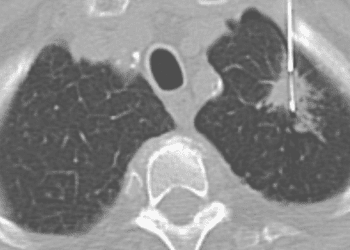Cancer mortality after low dose exposure to ionising radiation in workers
1. The risk of mortality from solid cancer, lagged by 10 years, is estimated to be increased by 52% per Gy of radiation exposure, an association that is doubled when limiting to the low cumulative dose range of 0-100 mGy.
2. There is an approximate relationship between cumulative dose radiation exposure and mortality from solid cancer.
3. Excluding cancers commonly associated with smoking and asbestos exposure did not alter the association between radiation exposure and solid cancer mortality substantially.
Evidence Rating Level: 2 (Good)
Although there is a known association between exposure to high dose radiation and cancer, the long-term risk from low dose and low dose rate radiation exposure is not well-studied. Therefore, the International Nuclear Workers Study (INWORKS) aimed to assess the mortality risk amongst nuclear workers to better elucidate the relationship between radiation dose and solid cancer mortality. The study population included workers from France, the UK, and the USA, employed in the nuclear industry for at least 1 year and who wear dosimeter monitors. Estimates were made of the individual annual exposure to radiation, converted to the absorbed dose of radiation to the colon, in gray (Gy) units. The primary outcome evaluated was mortality from solid cancers. As well, separate analyses were done excluding specific types of cancer, such as lung or pleura, to address confounding factors such as smoking or asbestos exposure. In this study, cumulative doses were lagged by 10 years to allow for a minimum period between radiation exposure and death, consistent with previous work done on this study and others. The study is ongoing, with the earliest data from the year 1955, including 309,932 workers with 10.7 million person-years of follow-up. In total, there were 31,009 deaths from cancer, with 28,089 being from solid cancer. The excess relative rate for any cancer mortality was 0.53 per Gy (90% CI 0.30-0.77) and for solid cancer mortality was 0.52 per Gy (90% CI 0.27-0.77). When examining lower cumulative dose ranges, the excess relative rates for solid cancer mortality were 0.63 per Gy (90% CI 0.34-0.92) for 0-400 mGy cumulative dose, 0.97 per Gy (90% CI 0.55-1.39) for 0-200 mGy cumulative dose, 1.12 per Gy (90% CI 0.45-1.80) for 0-100 mGy cumulative dose, and 1.30 per Gy (90% CI -1.33 to 4.06) for 0-20 mGy cumulative dose. Furthermore, a linear model was found to best depict the overall relationship between cumulative dose and solid cancer mortality, lagged by 10 years, including the low 0-200 mGy cumulative dose range. In addition, the excess relative rates for solid cancers excluding smoking-related cancers was 0.52 per Gy (90% CI 0.10-0.99), and when excluding lung and pleura cancers to control for asbestos exposure, it was 0.43 per Gy (90% CI 0.15-0.73), both of which were similar to the overall relative rate. Overall, this study found a linear dose-response association between radiation exposure and mortality from solid cancer, with the strength of the association being twice as great in the lower cumulative dose range, and with no clear changes when adjusting for smoking and asbestos exposure.
Click to read the study in BMJ
Image: PD
©2023 2 Minute Medicine, Inc. All rights reserved. No works may be reproduced without expressed written consent from 2 Minute Medicine, Inc. Inquire about licensing here. No article should be construed as medical advice and is not intended as such by the authors or by 2 Minute Medicine, Inc.


![2 Minute Medicine: Pharma Roundup: Price Hikes, Breakthrough Approvals, Legal Showdowns, Biotech Expansion, and Europe’s Pricing Debate [May 12nd, 2025]](https://www.2minutemedicine.com/wp-content/uploads/2025/05/ChatGPT-Image-May-12-2025-at-10_22_23-AM-350x250.png)






